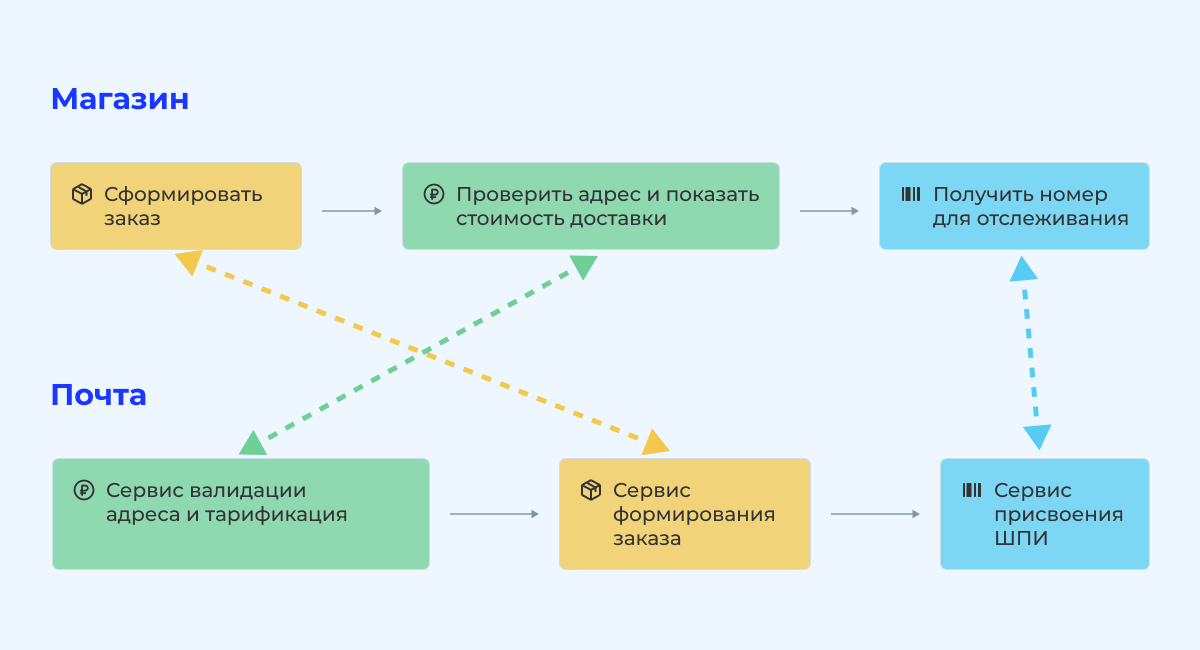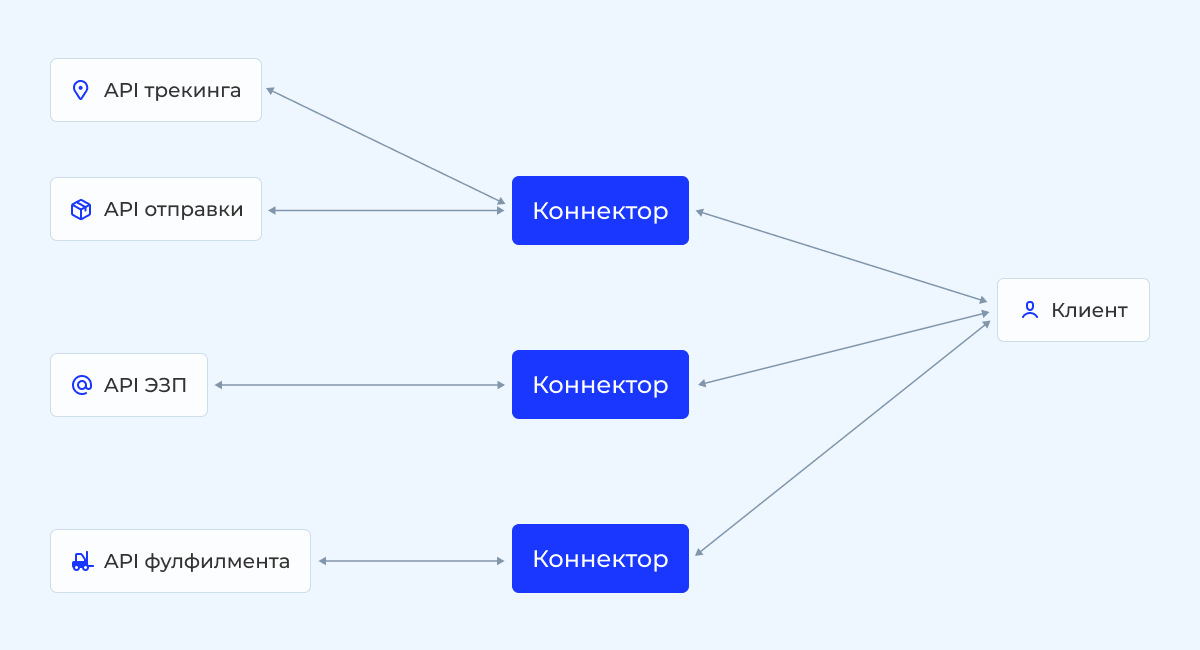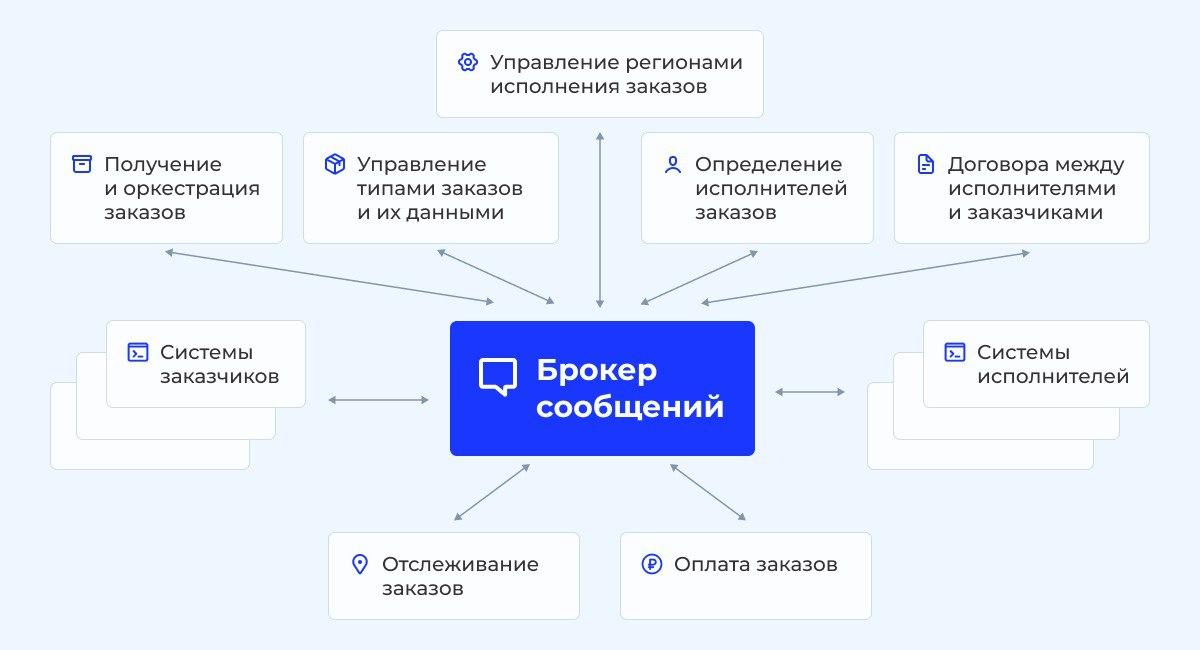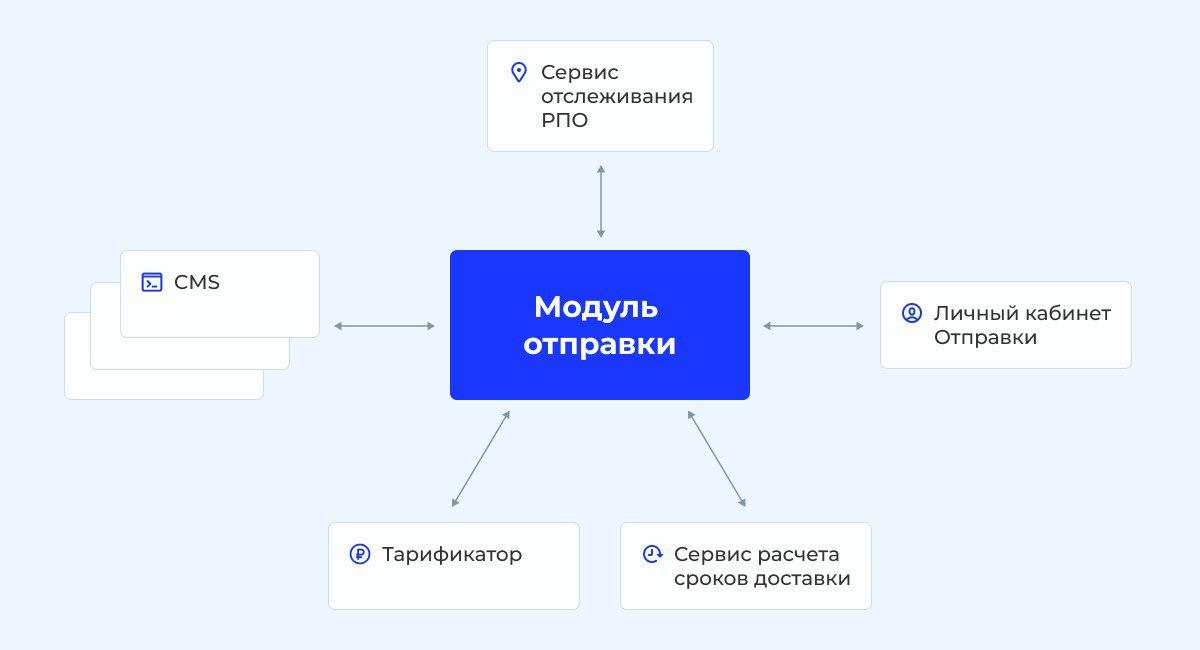So far, a separate system is responsible for each of these processes. To use the service of electronic registered letters, sending or fulfillment requires integration with each of them. And we want to make sure that the client gets access to all the features of Mail on a “one-stop-shop” basis, without extra effort and much faster. To implement this idea, we are creating an integration platform that we want to tell you about.
We combine integrations in a "one window"
To facilitate access to all mail services, we will need a system that will: 1) connect the Mail API to the store’s API without deeply diving into everyone’s business processes; 2) connect all our services through a "one window". These tasks will be solved by the integration platform.
Now, to integrate the client with its API into the Sending , fulfillment or registered emails, we are writing an individual connector. Each service has its own. A connector is a "translator" that helps the store and the Post to understand each other. It decrypts the information from the client API into our format, and then does it in the opposite direction.
We made one of these connectors to connect the Beru marketplace to Dispatch, a service that automates the preparation of parcels for delivery to branches. The connector receives data from the Yandex API in XML format, translates it into JSON for transfer to the Sending personal account, and adjusts our work order to the client process.
On the part of the Mail, there are several actions: assign a track number, send data to the system, transfer data to tracking. At the store: place an order, check the address, show the shipping cost and get a tracking number. These actions in the processes of the Mail and the store have a different order and can be called differently. Our first step is to check the address and calculate the tariff, and the store first generates an order. It is necessary to help compare these steps so that the two systems can understand each other.

The store sends the Mail a request "Create a new parcel from Moscow to Saratov weighing 1 kg", and the connector decomposes it into variables understandable for our API "Create a new parcel" "Route: Moscow - Saratov" "Weight: 1 kg". If Beru wants to connect to Fulfillment in order to store and send goods from our warehouse, then he will need to write another connector.

The usual process of connecting to Mail services
The good news is that connectors are written for a specific API format (XML, JSON, etc.), so they can be reused for clients with similar requirements. But for this to work, you need to create a kernel through which all mail services will communicate and to which ready-made connectors will connect. This core, the basis of the integration platform, will be the general postal order management system. Then the connection process will look like this:

Connection to all Mail services through the integration platform
The platform will operate on the principle of a BPMN system, in which analysts build a business process for a specific action. It will allow you to convert data from any format to the desired one. All that remains to be done manually is to connect the variables to manage the order.
With the help of connectors, we translate the data format and compare the order of actions, which takes one to two months. And the integration platform will allow you to connect a new client to all our systems in one or two weeks without complex developments, with minimal involvement of programmers.
We change the structure of work with orders
Now all mail operations are controlled by disparate systems, each of which is responsible for its own step and does not exchange data with the rest. OMS will integrate all tasks and will work with them from one point.
A unified order management system will cover all customer needs within the Mail ecosystem. We will be able to pick up stock balances from one warehouse, transfer it to fulfillment, prepare it for shipment and ship it for delivery. It will also expand the capabilities of our internal processes - it will allow us to launch services that the Post does not yet provide: delivery of bulky goods, courier delivery from a branch to a specific recipient, and others.
A general postal order management system can be imagined as a multi-armed operator who accepts all incoming tasks, determines priorities and deadlines, decides who and when to transfer the task, controls all changes in the order from the moment of receipt to completion.

OMS Scheme
For example, we received an application for the delivery of a refrigerator that needs to be raised to the 25th floor without an elevator. The Post does not have a delivery service for such a large product and does not have its own movers. OMS will select a suitable performer among our partners and send the task to him. And when a partner receives an order for parcels that do not fit into his car, we can pick up the order for ourselves and reload our own transport. Due to the fact that each OMS participant can act as a customer and an executor, we will have the opportunity to distribute orders between the Mail and partners in such a way as to optimally use the resources of each.
The OMS pilot inside the Post will begin in the next month. Then we will start developing an integration platform that will integrate the OMS order lifecycle with the client's business processes. Soon, one simple integration will be enough to connect several Mail services.
Open Mail API
Connectors are needed only for those online sites that have their own API standards. Those who do not have such restrictions can connect their warehouse, sorting system or workflow to the data exchange through the open tracking APIs and the sending parcels API .
This opportunity uses OZON. With the usual API capabilities, we were able to close the entire chain of creation, preparation and tracking of packages for a huge marketplace that sends 300-400,000 packages a month via Mail:
- API - OZON . – , . , .
- OZON.
- API OZON . , , , .
The API is used by customers with their own order management system. If your store runs on one of the popular CMS: InSales, amoCRM, ShopScript, 1C-Bitrix or CS: Cart, then you can use applications that operate on the basis of the official Mail module.
Module for stores on CMS platforms
The module sends the parameters of the package from the store basket to the tariffication , time calculation service and tracking service. From there we get information about the delivery time and cost and transfer it to the personal account of the Sending, where the preferred preparation takes place - an address label is formed and a track number is assigned.

From the Sending personal account, documents and tracking data are returned to the store management system interface. The seller can print labels for delivery of parcels and transfer track numbers to customers in his usual CRM.
Branch selection widget
If buyers fill out all the order data without leaving the site, then the conversion to purchases will be higher. So that at the stage of registration of delivery they do not have to remember the address, zip code and operating hours of the nearest branch or look for this information outside the seller's website, you can use a widget with a map of post offices and points of issue of orders.
The client selects a branch on the map and sees information about it: address, opening hours, payment methods, as well as the cost and delivery time, which are pulled from the open API services tariff.pochta.ru and delivery.pochta.ru .

The buyer receives all the important information in one window - the term, cost and schedule of the department
You don't need any special knowledge to install a widget on a website or application. The constructor is configured in a few clicks and is available at widget.pochta.ru .
Although we have a set of solutions that close almost any request from a business, we do not stop there and create a single entry point for customers. With it, companies will receive tools for easier integration of logistics into their processes, and Mail is another powerful channel for promoting and developing their products and services.
If you share this approach and want to participate in the transformation of services that will be used by hundreds of online stores throughout the country, then we are waiting for you in the Postal Technologies team. Open vacancies in 9 cities of Russia can be viewed at hr.pochta.tech/vacancies .